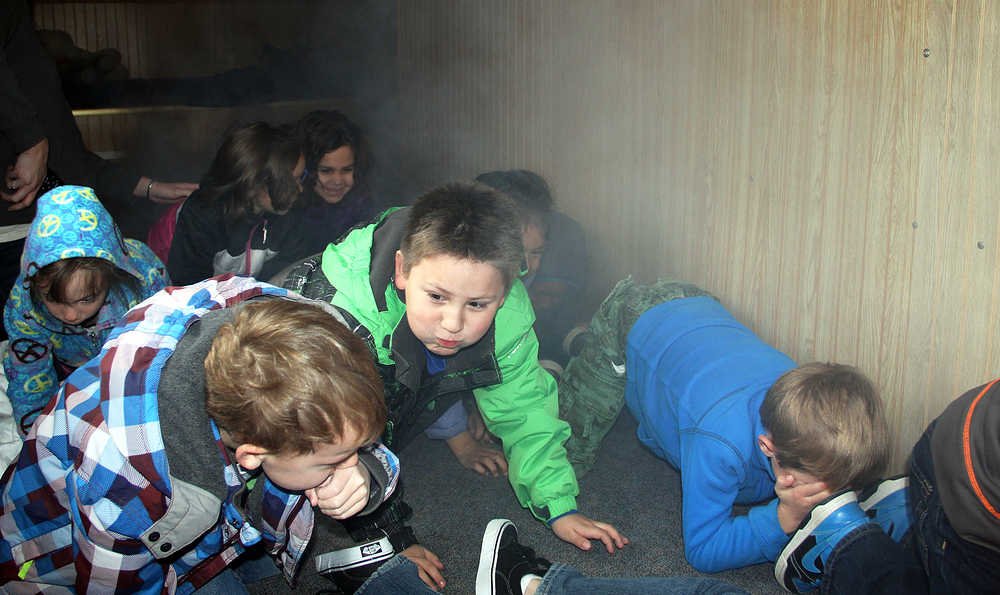October is a month traditionally associated with falling leaves, pumpkins and shorter days, but elementary school students in Kenai are learning the importance of what to do in the event of a house fire. Nationwide, October 5-12 is Fire Prevention Week and throughout the month Kenai firefighters are visiting classes to remind kids that fire drills are not just something to be practiced at school.
So far this year, nine people have died in fires in Alaska, according to the state division of fire and life safety.
Kenai Fire Marshal Tommy Carver said that while the schools do a good job of practicing fire drills every month, few children practice escaping from a fire at home.
“Our emphasis is to get them thinking about setting up a plan at home and talk to their parents,” Carver said. “It gives them responsibility to bring it up to their family and get everyone involved.”
With the changing season and daylight savings approaching, Carver said this is the time each year firefighters tell the students to ask parents to test smoke detectors. Batteries should be changed twice a year and it is a good practice to change them out when people change their clocks, he said.
“We don’t want smoke detectors to become a nuisance alarm,” Carver said. “Most of the fires we come across, the house didn’t have a working smoke alarm.”
This week Kenai firefighters visited Mountain View Elementary School classes and talked to the kids about practicing escape routes with their families and that the practice could save their lives. In Mandi Vaala’s first grade class Thursday, Kenai Fire Capt. John Harris asked the students how they practice fire drills at school.
“We line up at the door and our teacher walks us out to the parking lot,” said one student.
“Then she calls our names to make sure we are all safe,” said another.
The students also demonstrated how to stop, drop, roll and cover their face if any part of them catches fire. Covering their face will keep smoke out of their eyes, nose and mouth, Harris said. Firefighter Pete Coots stressed the importance to have a working smoke detector.
Kenai firefighter Dustin Voss brought his bunker gear so the class could see what a firefighter would look like when responding to a fire. He told the class if they were stuck inside a burning building to not be afraid of them because they are there to help.
First grader Jasmine Olson said she learned not to hide from firefighters in a burning building.
After talking with the class, the class had the opportunity to put their skills to the test. The firefighters brought their two-story fire safety house trailer, equipped with a control room that simulates a kitchen fire with fake smoke rising up to the second floor. The kids then practice how to exit when the smoke detector alarms and smoke fills the house.
Voss led Vaala’s class upstairs and the students pretended to go to sleep when the smoke detectors sounded and smoke filled the room.
“Smoke goes up so the only place is down low,” he said.
Voss showed the class how to stay low to the floor and crawl when exiting a room. He showed them how to check for a hot door, using the back side of their hands, so they don’t open the door to a fire.
“Always look for two exits in every room,” Voss said.
On the second floor, he showed the kids they can open a window and can use bed sheets to climb down, but cautioned them not to jump to the ground because they could hurt themselves.
With the older kids, Carver said they explain if the only way to save their live would be to drop out of a second story window, they describe the safest way to do so. Firefighters also shared the safest way to break a window to escape a fire.
Voss then showed the class to crawl down the stairs backwards so reduce the amount of smoke that could get in their lungs. After all the students exited, the kids gave the firefighters high-fives.
Carver said he enjoys spending time at the schools with the kids and has lunch with them, which helps the kids get more comfortable around firefighters.
“Having worked in Kenai for so many years, its cool to see the kids at the grocery store who remember the class,” he said. “By middle school, they have five years of solid fire prevention skills. It’s a great way for us to interact with the community.”
Later this month, the Kenai Fire Department will also visit classes at Kaleidoscope School of Arts and Science and Aurora Borealis charter school. Carver said by the end of the month firefighters would visit with nearly 1,000 students from ranging from kindergartners to fifth graders. With each, they’ll show a video, targeted toward a specific age group, that educates the kids on fire prevention.
“By the fourth and fifth grades we leave the cartoons behind and the video is more realistic,” he said. “In the video the kids believe someone died in the fire through all the panic and confusion but in the end everyone gets out. It shows the importance of having a meeting place.”
Carver said candles are another fire danger they see a lot on calls.
“The problem is they don’t make any sound and you get used to the smell after a few minutes,” he said. “People forget about them and leave the room unattended. We see fires like that every year. We teach kids if they see a candle unattended to get the parents attention.”

